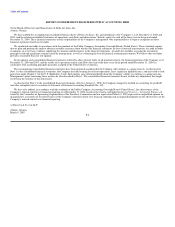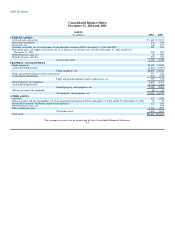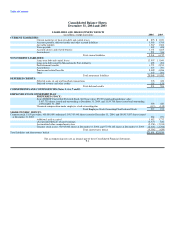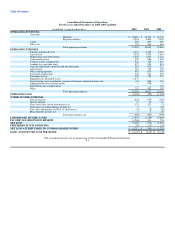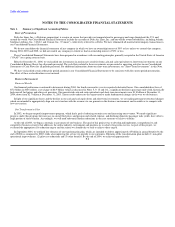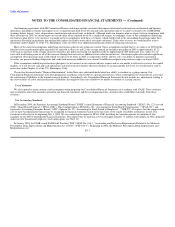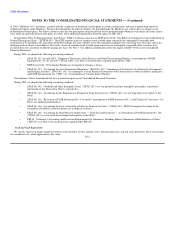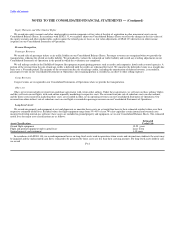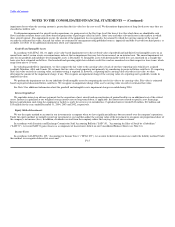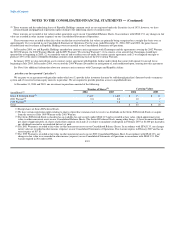Delta Airlines 2004 Annual Report Download - page 67
Download and view the complete annual report
Please find page 67 of the 2004 Delta Airlines annual report below. You can navigate through the pages in the report by either clicking on the pages listed below, or by using the keyword search tool below to find specific information within the annual report.
Table of Contents
NOTES TO THE CONSOLIDATED FINANCIAL STATEMENTS — (Continued)
a lower cost structure. Under SimpliFares, we lowered unrestricted fares on some routes by as much as 50%; reduced the number of fare categories;
implemented a fare cap; and eliminated the Saturday-night stay requirement that existed for certain fares. While SimpliFares is expected to have a negative
impact on our operating results for some period, we believe it will provide net benefits to us over the longer term by stimulating traffic; improving
productivity by simplifying our product; and increasing customer usage of delta.com, our lowest cost distribution channel.
Liquidity
Due to the difficult revenue environment, historically high fuel prices and other cost pressures, we borrowed $2.4 billion in 2004 to fund daily operations
and capital requirements, repay debt obligations and increase our liquidity. These borrowings included $830 million that we obtained during the December
2004 quarter under our financing agreements with GE Commercial Finance and American Express Travel Related Services Company, Inc. ("Amex"). These
new financing agreements are essential elements of our ongoing restructuring efforts. Our borrowings under these agreements are secured by substantially all
of our assets that were unencumbered immediately prior to the consummation of those agreements. During 2004, we also deferred to later years certain debt
obligations that were due in 2004, 2005 and 2006. See Note 6 for additional information about our financing agreements with GE Commercial Finance and
Amex, as well as our deferrals of debt during 2004.
At December 31, 2004, we had cash and cash equivalents, and short-term investments totaling $1.8 billion. In March 2005, we borrowed the final
installment of $250 million under our financing agreement with Amex. We have commitments from a third party to finance on a long-term secured basis our
purchase of 32 regional jet aircraft to be delivered to us in 2005 ("Regional Jet Credit Facility") (see Note 6). We have no other undrawn lines of credit.
We have significant obligations and commitments due in 2005 and thereafter. Our obligations due in 2005 include approximately (1) $1.1 billion in
operating lease payments; (2) $1.0 billion in interest payments, which may vary as interest rates change on our $5 billion principal amount of variable rate
debt; (3) $835 million in debt maturities, approximately $630 million of which we expect will be cash payments (see Note 6); and (4) $450 million of
estimated funding for our defined benefit pension and defined contribution plans. Absent the enactment of new federal legislation which reduces our pension
funding obligations during the next several years, our annual pension funding obligations for each of 2006 through 2009 will be significantly higher than in
2005 and could have a material adverse impact on our liquidity.
During 2005, we expect capital expenditures to be approximately $1.0 billion. This covers approximately $540 million for aircraft expenditures, which
includes $520 million to purchase 32 regional jets which we intend to finance under the Regional Jet Credit Facility. Our anticipated capital expenditures for
2005 also include approximately $215 million for aircraft parts and modifications, and approximately $285 million for non-fleet capital expenditures.
As discussed above, we do not expect to achieve the full $5 billion in targeted benefits under our transformation plan until the end of 2006. As we
transition to a lower cost structure, we continue to face significant challenges due to low passenger mile yields, historically high fuel prices and other cost
pressures related to interest expense and pension and related expense. Accordingly, we believe that we will record a substantial net loss in 2005, and that our
cash flows from operations will not be sufficient to meet all of our liquidity needs for that period.
We currently expect to meet our liquidity needs for 2005 from cash flows from operations, our available cash and cash equivalents and short-term
investments, the Regional Jet Credit Facility, and the final $250 million borrowing under our financing agreement with Amex. Because substantially all of our
assets are encumbered and our credit ratings are low, we do not expect to be able to obtain any material amount of additional debt financing. Unless we are
able to sell assets or access the capital markets by issuing equity or convertible debt securities, we expect that our cash and cash equivalents and short-term
investments will be substantially lower at December 31, 2005 than at the end of 2004.
F-10




